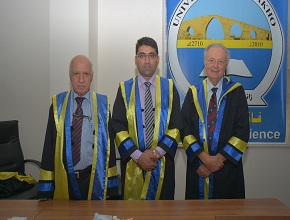

Published Date: Saturday, 7 November 2015, 00:00
The debates of the Split- Site PhD student Mr. Sarbast Ahmad Mahmud was held at the University of Zakho about his research project entitled Phytochemical Screening and Anti-contractile Effects of Some Active Ingredients of Crataegus Azarolus Var. Aronia on Isolated Aorta of Rats Aorta on the 22nd of October, 2015.
The Split-Site PhD student carried out his research project under the supervision of Prof. Dr. Omar Al-Habib, Vice- President for Scientific Afffairs and Postgraduate Studies at the University of Zakho, and Prof. Dr. Giovanni Vidari, lecturer at the University of Pavia/ Italy. It is worthwhile to mention that Mr. Mahmud did a part of his work in the Chemistry Research Laboratory at the University of Pavia and completed the remaining part at the Physiology Research Laboratory at the University of Zakho, Kurdistan Regional Government-Iraq.
He showed in his presentation of his research project, that he isolated one novel triterpenoid Azarolic acid and four new triterpenoids (Euscaphic acid, 2α, 19α-dihydroxy-3-oxo-urs-12-en-28-oic acid, 2-oxopomolic acid and Arjunic acid) for the first time from Crataegus aronia var. azarolus. In addition, he also re-confirmed the presence of four flavonoids, namely, Epicatechin, 4-acetylvitexin-2O-rhamnoside, (iso) vitexin-2-O-rhamnoside and vitexin in C. azarolus.
Furthermore, in the pharmacological part of the study on the effect of some of the above triterpenoids, the tested compounds such as Azarolic acid, Euscaphic acid, 2α, 19α-dihydroxy-3-oxo-urs-12-en-28-oic acid, showed potent vasorelaxant effects on aorta of rats. In addition, it has been proved using different types of ion channel blockers that the vasorelaxant effects are attributed to the role of various K+ Channels subtypes and L-type slow Ca2+ channels. For example, the anti-vasoconstriction effect of euscaphic acid was mediated via enhancement of opening of KCa and blockade of L-typeCa2+ channels. On the other hand, KATP, KIR, and KV subtypes did not play any significant role in anti-vasoconstriction produced by euscaphic acid.
The results of the current research project are promising with respect to the preparation of drugs from these compounds that were used for the treatment of cardiovascular diseases.
